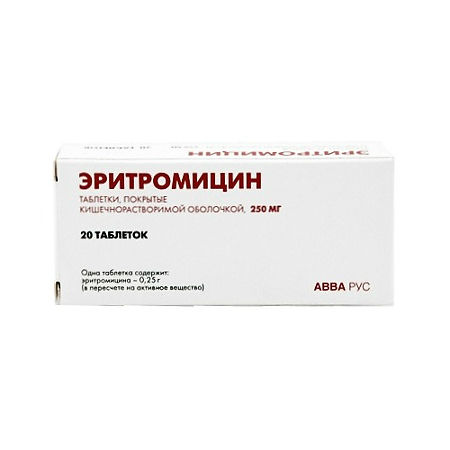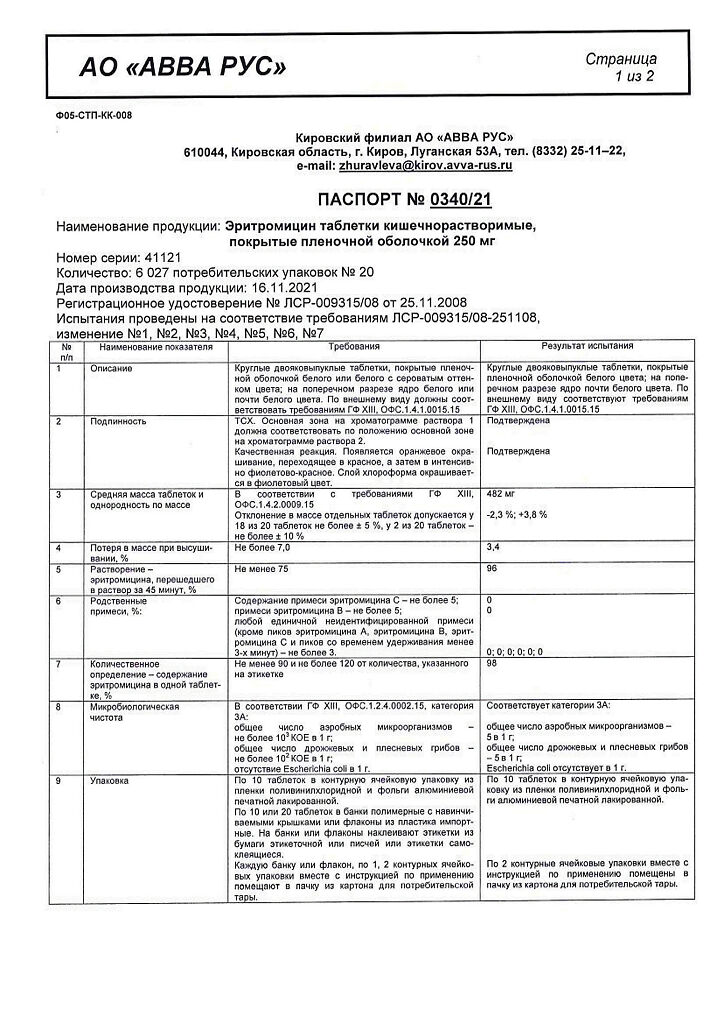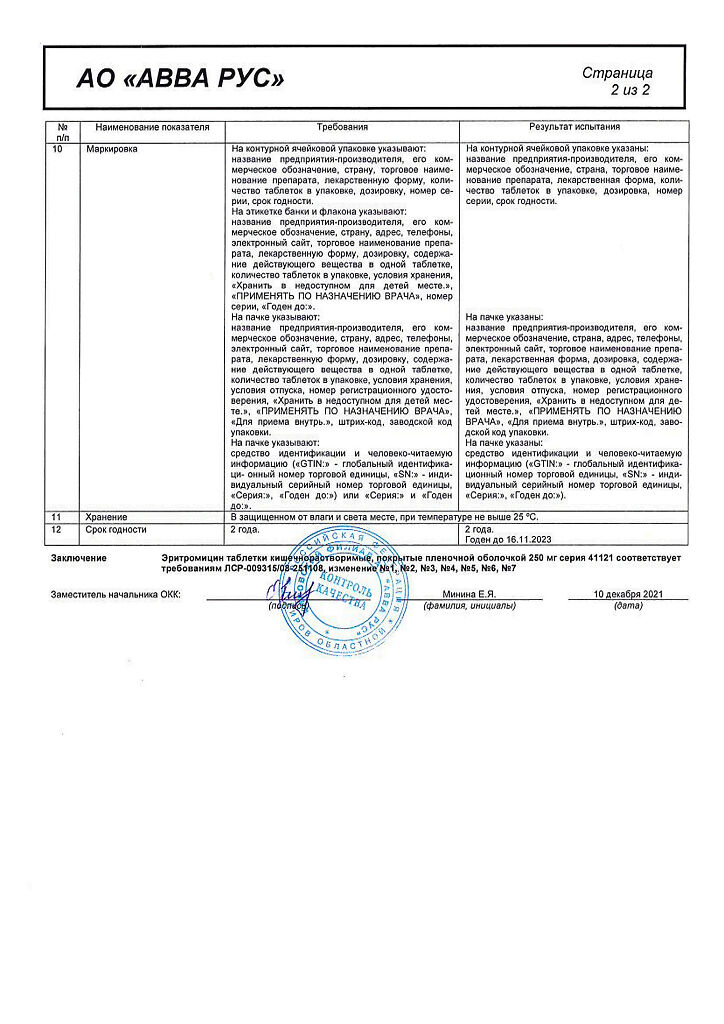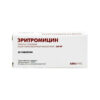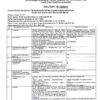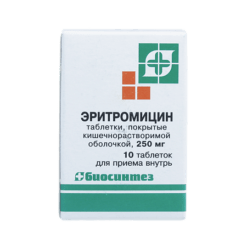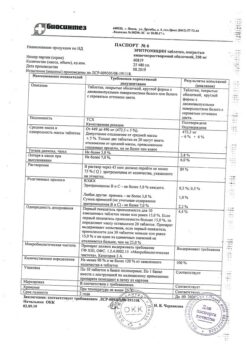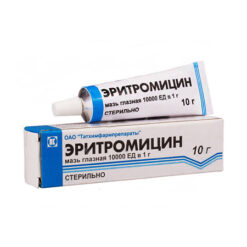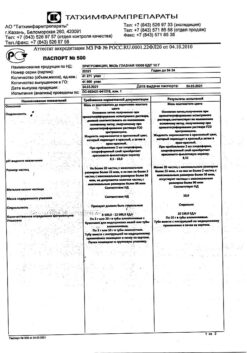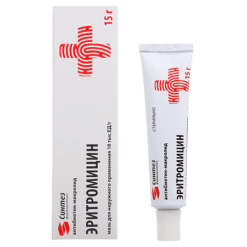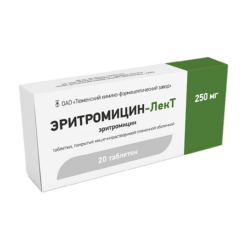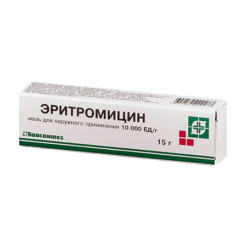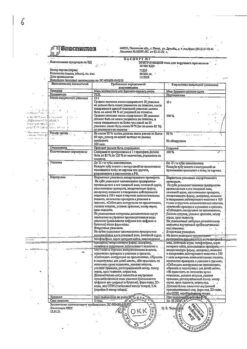No products in the cart.
Erythromycin, 250 mg 20 pcs
€8.44 €7.38
Out of stock
(E-mail when Stock is available)
Description
Bacteriostatic antibiotic of macrolide group, binds reversibly to 50S-subunit of ribosomes in its donor part, which disrupts formation of peptide bonds between amino acid molecules and blocks protein synthesis of microorganisms (does not affect nucleic acid synthesis). When used in high doses it may show bactericidal effect.
The spectrum of action includes Gram-positive (Staphylococcus spp, producing and not producing penicillinase, including Staphylococcus aureus, Streptococcus spp (including Streptococcus pneumoniae, Streptococcus pyogenes), alpha-hemolytic streptococcus (Viridans group), Bacillus anthracis, Corynoebacterium diphtheriae, Corynoebacterium minutissimum) and gram-negative microorganisms (Neisseria gonorrhoeae, Haemophilus influenzae, Bordetella pertussis, Brucella spp, Legionella spp. including Legionella pneumophila) and other microorganisms: Mycoplasma spp. (including Mycoplasma pneumoniae), Chlamydia spp. (including Chlamydia trachomatis), Treponema spp., Rickettsia spp., Entamoeba histolytica, Listeria monocytogenes.
Resistant Gram-negative bacilli: Escherichia coli, Pseudomonas aeruginosa as well as Shigella spp., Salmonella spp. and others.
It is a motilin receptor agonist. It accelerates the evacuation of gastric contents by increasing the amplitude of contraction of the pylorus and improving the antral-duodenal coordination.
Indications
Indications
The prevention of exacerbations of streptococcal infection (tonsillitis, pharyngitis) in patients with rheumatism. Prevention of infectious complications during medical and diagnostic procedures (including preoperative preparation of the intestine, dental interventions, endoscopy, in patients with cardiac defects).
It is a reserve antibiotic for the treatment of bacterial infections caused by strains of Gram-positive pathogens (in particular, staphylococci) which are resistant to penicillin.
Eritromycin is the drug of choice in patients with hypersensitivity to penicillins.
Active ingredient
Active ingredient
Composition
Composition
Eritromycin 250 mg.
Supplementary substances:
povidone – 9.45 mg,
crospovidone – 13.5 mg,
calcium stearate – 4.14 mg,
talc – 10.35 mg,
potato starch – to a core weight of 450 mg.
Shell composition:
Cellacephate 16.2 mg, titanium dioxide 0.8 mg, castor oil 3 mg.
How to take, the dosage
How to take, the dosage
The drug should be taken orally on an empty stomach or 1 hour before a meal.
The tablet should not be divided or chewed.
Eritromycin should be taken for at least 2 to 3 days after the symptoms have gone. In infections caused by group A streptococci, erythromycin should be taken for at least 10 days.
Doses
The dose depends on clinical and microbiological studies, as well as the general condition of the patient.
The average daily dose for adults is 1 to 2 g in 2 to 4 doses, the maximum daily dose is 4 g.
In children under 18 years of age, depending on the age, body weight and severity of infection – 30-50 mg/kg/day in 2-4 doses. In severe infections the dose can be doubled.
For treatment of diphtheria carrier – 0.25 g 2 times a day. The course dose for the treatment of primary syphilis is 30-40 g, the duration of treatment is 10-15 days.
In case of amebic dysentery in adults – 0.25 g 4 times a day, in children – 30-50 mg/kg/day; course duration – 10-14 days.
In case of legionellosis it is taken 0.5-1 g 4 times a day for 14 days.
In case of gonorrhea – 0.5 g every 6 hours for 3 days, then 0.25 g every 6 hours for 7 days.
For preoperative bowel preparation to prevent infectious complications – orally, 1 g at 19 h, 18 h and 9 h before surgery (3 g in total).
For prevention of streptococcal infection (tonsillitis, pharyngitis) in adults – 20-50 mg/kg/day, in children – 20-30 mg/kg/day, the course duration – at least 10 days.
For prophylactic septic endocarditis in patients with cardiac defects – 1 g for adults and 20 mg/kg for children, 1 hour before therapeutic or diagnostic procedure, then 0.5 g for adults and 10 mg/kg for children, repeated 6 hours later.
In pertussis, 40-50 mg/kg/day for 5-14 days.
Interaction
Interaction
Incompatible with lincomycin, clindamycin and chloramphenicol (antagonism). Reduces the bactericidal effect of beta-lactam antibiotics (penicillins, cephalosporins, carbopenems). Increases theophylline.
Drugs that block tubular secretion prolong the half-life of erythromycin.
Concomitant use with drugs which are metabolized in the liver (carbamazepine, valproic acid, hexobarbital, phenytoin, alfentanil, disopyramide, lovastatin, bromocretin) may increase plasma concentration of these drugs (is an inhibitor of microsomal liver enzymes).
It enhances nephrotoxicity of cyclosporine (especially in patients with concomitant renal failure). Reduces clearance of triazolam and midazolam, in connection with which it may increase the pharmacological effects of benzodiazepines.
In concomitant use with terfenadine or astemizole – possibility of arrhythmia (ventricular fibrillation and flutter, ventricular tachycardia, up to death), with dihydroergotamine or unhydrogenated ergot alkaloids – narrowing of vessels to spasm, dysesthesia.
Delays elimination (increases the effect) of methylprednisolone, felodipine and coumarin-type anticoagulants.
In co-administration with lovastatin it increases rhabdomyolysis.
Induces bioavailability of digoskin.
Decreases the effectiveness of hormonal contraception.
Special Instructions
Special Instructions
Symptoms of cholestatic jaundice may develop within a few days after initiation of therapy, but the risk of development increases after 7-14 days of continuous therapy.
The likelihood of ototoxic effects is higher in patients with renal and hepatic impairment and in elderly patients.
Some resistant strains of Haemophilus influenzae are sensitive to simultaneous administration of erythromycin and sulfonamides.
May interfere with the determination of catecholamines in the urine and “hepatic” transaminase activity in the blood (colorimetric determination with definylhydrazine).
In newborns receiving erythromycin, there is a high risk of pylorostenosis. Numerous clinical studies have proven the antral and duodenal prokinetic effect of erythromycin.
During long-term treatment with erythromycin it is necessary to monitor laboratory indicators of liver function.
Cautiously use in patients treated concomitantly with drugs whose metabolism involves cytochrome P-450-dependent monooxidases.
The antibiotics of wide antibacterial spectrum (e.g., macrolides, semi-synthetic penicillins, cephalosporins) can sometimes cause pseudomembranous colitis. Suppression of normal bacterial flora in the gut promotes the development of Clostridium difficile, whose toxins cause the clinical symptoms of pseudomembranous colitis. Therefore, patients who have diarrhea during antibiotic treatment or immediately after its withdrawal should not treat themselves and should consult a physician.
If pseudomembranous colitis is confirmed, erythromycin should be stopped immediately and appropriate treatment begun. In mild cases it is sufficient to cancel the drug; in more severe cases, metronidazole or vancomycin should be taken. Administration of drugs inhibiting intestinal peristalsis or other anti laxatives is contraindicated.
Contraindications
Contraindications
With caution, use in patients with hepatic functional impairment, arrhythmias (history), prolonged QT interval, jaundice (history), hepatic or renal failure, during lactation.
Side effects
Side effects
Digestive system disorders: nausea, vomiting, gastralgia, abdominal pain, tenesmus, diarrhea, dysbacteriosis, rarely – oral candidiasis, pseudomembranous enterocolitis, liver dysfunction, cholestatic jaundice, increased activity of “liver” transaminases, pancreatitis.
Diarrhea occurring during treatment with erythromycin should be reported to the physician, as it may be a symptom of pseudomembranous enterocolitis.
In long term or repeated treatment with erythromycin, superinfections caused by bacteria or fungi resistant to the drug can occur.
Hearing disorders: reversible ototoxicity – decreased hearing and/or tinnitus (when using high doses – more than 4 g/day).
Cardiovascular system disorders: rare – tachycardia, prolonged QT interval on electrocardiogram, atrial fibrillation and/or flutter (in patients with prolonged QT interval on electrocardiogram).
Allergic reactions: urticaria, other forms of skin rash, eosinophilia, rarely – anaphylactic shock.
Other adverse events which may occur after taking erythromycin: agranulocytosis, nervous system disorders (dizziness, states of confusion, hallucinations), nightmares.
Overdose
Overdose
Symptoms: impairment of liver function, up to acute hepatic failure, hearing loss.
Treatment: activated charcoal, close monitoring of the respiratory system (if necessary – artificial ventilation), acid-base status and electrolyte metabolism, electrocardiography. Hemodialysis, peritoneal dialysis, forced diuresis are ineffective.
Pregnancy use
Pregnancy use
The use of erythromycin in pregnant and breastfeeding women is not recommended only if the expected benefits exceed the potential harms.
Due to the possibility of penetration into the breast milk, erythromycin should be refrained from breastfeeding.
Similarities
Similarities
Additional information
| Weight | 0.020 kg |
|---|---|
| Shelf life | 3 years. |
| Conditions of storage | Store at temperatures up to 25°C. Protect from moisture. Keep out of reach of children. |
| Manufacturer | Avva Rus, Russia |
| Medication form | enteric-soluble film-coated tablets |
| Brand | Avva Rus |
Other forms…
Related products
Buy Erythromycin, 250 mg 20 pcs with delivery to USA, UK, Europe and over 120 other countries.

